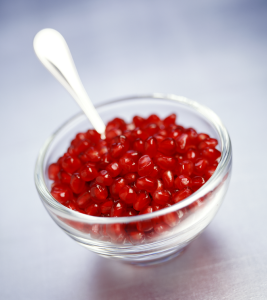Everything to Know About Pomegranates
As we approach the winter solstice on December 21st and the days continue to get shorter, the produce section at our local supermarket can look somewhat lackluster. The same fruits and vegetables most of us are accustomed to aren’t in season any longer, and so while favorites like strawberries or tomatoes are available – they aren’t pretty. One exception is the pomegranate – currently at their peak of their perfection.
Originating in locations ranging from Iran to Northern India, the pomegranate has been used for many purposes throughout history and is referenced in both the Old Testament of the Bible and in the Babylonian Talmud. Aside from simply eating the seeds (known as “arils”), the fruit is also valued for its thirst-quenching juice. Additionally, pomegranate rind and tree flowers are both harvested to make dyes for use in textile manufacturing. Inks are made by steeping pomegranate leaves in vinegar and the Japanese use the bark to produce insecticides.
If you’ve never had the pleasure of opening a perfectly beautiful pomegranate, this is the perfect time to try. It’s like a work of art! Selecting and opening a pomegranate can be intimidating for beginners, but don’t be daunted. Read on to ensure you won’t waste time or money when you pick up this winter-time delicacy.
Picking Out a Pomegranate: The pomegranates in stores at this time of the year have been picked while ripe, so they should already be ready to enjoy right away. A proper pomegranate will feel heavy when ripe because it is full of juice. The skin on the pomegranate should feel tight and firm while looking a bit like leather. The color of the skin can range from a middle range red to a deep red. Unlike some other fruits and veggies, flaws on the surface of the skin do not indicate a lack of quality.
Cost: Pomegranates range in cost from $1 to $3, depending on the season and your location. Organic pomegranates may cost more.
Debating about buying organic? For those of you who try to buy organic whenever possible, pomegranates may not be something you have to stress over if you’re worried about your budget. Studies also show that pomegranates are not as susceptible to pesticide residues as other types of fruits, veggies and berries.
How to Store a Pomegranate: A pomegranate which hasn’t been opened can be stored for up to one month on the counter and up to two months if refrigerated. If you’ve removed the arils – the beautiful gem-like seed and juice pods – they will last for up to two weeks in an airtight container in the fridge. You can also freeze arils to savor for many months.
To freeze them – simply lay them in a single layer on a flat surface, like a cookie sheet, lined with wax paper or paper towels. Put them in the freezer until frozen – usually no more than two hours is required. Once they’re frozen, they’re ready to be put into a more convenient container such as a plastic bag. Freezing arils is a great way to enjoy them after they’re out of season.
Opening a Pomegranate: We here at Austin Air have used a few different approaches over the years but after much practice and discussion, we’ve settled on two methods which both work well. Pick your preference! Or try them both!
And if you’ve ever tried to hack it open your own way without looking it up first, you’ve seen why this is even a topic that we need to discuss… because it can be awful messy. In fact, we suggest wearing something which you wouldn’t mind getting messy or stained.
Method 1
Step 1: Cut
Using a sharp paring knife, cut off the top – about a half inch below the crown-looking part (which is actually called “the crown”). Be careful not to cut too deep into the rind, as it is fairly thin compared to a citrus.
Step 2: Score
Each pomegranate has either four or six sections divided by a white membrane. Once the top has been removed, each of the sections will be visible. With the knife’s point, score the skin along each section from top to bottom.
Step 3: Open and Loosen
Turn the pomegranate upside-down, and carefully (using both hands) separate the cut sections of the pomegranate over a bowl.
Step 4: Apply Pressure
Whack the bottom with a wooden spoon or blunt object, and watch the seeds fall out!
Step 5: Sort and Enjoy!
Pick out membrane pieces that remain and discard them. The arils are now ready for consumption!
Method 2:
Step 1: Cut
This is the same as step one from the previous method: cut off the top – about a half inch below the crown.
Step 2: Score
You’ll also recognize this step: score the skin along each of the now visible sections from top to bottom.
Step 3: Open
Using both hands, carefully pull the pomegranate apart in a large bowl of water, breaking it into smaller sections.
Step 4: Loosen
Under water, loosen the arils and allow them to sink to the bottom of the bowl; the membrane will conveniently float to the top.
Step 5: Scoop
Use a spoon to scoop out the pieces of white membrane that have floated to the top of the water. You won’t want to eat those! It is said that it’s nutritious so feel free to give it a try but it isn’t what most people would call “tasty”.
Step 6: Strain and Enjoy!
Pour the arils and remaining liquid through a strainer. The arils are now ready for consumption!
One Last Thing to Remember:
When opening a Pomegranate, understand that each aril or seed is under a lot of pressure, and the dark red juice often pops or explodes while trying to open or cut into the fruit. Almost like how a steamed corn kernel will shoot it’s starchy liquid, even biting into a pomegranate aril will cause it to shoot out it’s juice. So you’ll want to ensure you don’t ruin your clothing or table cloths, since the juice is likely to stain due to it’s dark color and viscosity. In fact, it will even stain your kitchen table or counter, so I usually put down a layer of paper towels when I get ready to open and eat a pomegranate.
Voilà! You are now ready to buy and enjoy a pomegranate while they are at their peak in perfection! American supplies usually come from California for most of the season but pomegranates are grown all over all over the world so grocery stores are able to supplement their produce sections – meaning you can enjoy pomegranates all year long.

